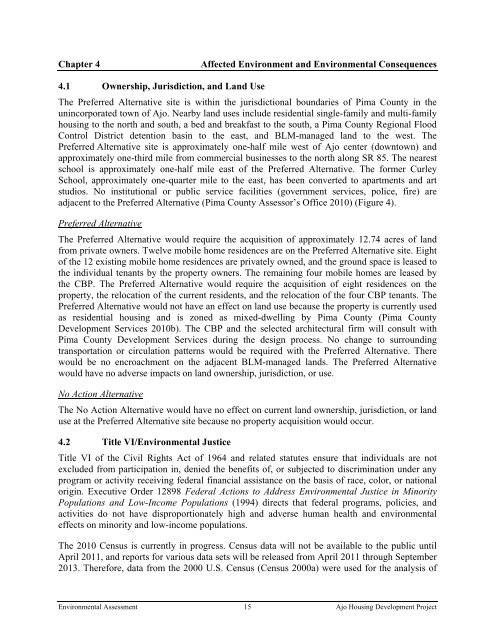US Customs and Border Protection Ajo Housing Development ... - GSA
US Customs and Border Protection Ajo Housing Development ... - GSA
US Customs and Border Protection Ajo Housing Development ... - GSA
You also want an ePaper? Increase the reach of your titles
YUMPU automatically turns print PDFs into web optimized ePapers that Google loves.
Chapter 4<br />
Affected Environment <strong>and</strong> Environmental Consequences<br />
4.1 Ownership, Jurisdiction, <strong>and</strong> L<strong>and</strong> Use<br />
The Preferred Alternative site is within the jurisdictional boundaries of Pima County in the<br />
unincorporated town of <strong>Ajo</strong>. Nearby l<strong>and</strong> uses include residential single-family <strong>and</strong> multi-family<br />
housing to the north <strong>and</strong> south, a bed <strong>and</strong> breakfast to the south, a Pima County Regional Flood<br />
Control District detention basin to the east, <strong>and</strong> BLM-managed l<strong>and</strong> to the west. The<br />
Preferred Alternative site is approximately one-half mile west of <strong>Ajo</strong> center (downtown) <strong>and</strong><br />
approximately one-third mile from commercial businesses to the north along SR 85. The nearest<br />
school is approximately one-half mile east of the Preferred Alternative. The former Curley<br />
School, approximately one-quarter mile to the east, has been converted to apartments <strong>and</strong> art<br />
studios. No institutional or public service facilities (government services, police, fire) are<br />
adjacent to the Preferred Alternative (Pima County Assessor’s Office 2010) (Figure 4).<br />
Preferred Alternative<br />
The Preferred Alternative would require the acquisition of approximately 12.74 acres of l<strong>and</strong><br />
from private owners. Twelve mobile home residences are on the Preferred Alternative site. Eight<br />
of the 12 existing mobile home residences are privately owned, <strong>and</strong> the ground space is leased to<br />
the individual tenants by the property owners. The remaining four mobile homes are leased by<br />
the CBP. The Preferred Alternative would require the acquisition of eight residences on the<br />
property, the relocation of the current residents, <strong>and</strong> the relocation of the four CBP tenants. The<br />
Preferred Alternative would not have an effect on l<strong>and</strong> use because the property is currently used<br />
as residential housing <strong>and</strong> is zoned as mixed-dwelling by Pima County (Pima County<br />
<strong>Development</strong> Services 2010b). The CBP <strong>and</strong> the selected architectural firm will consult with<br />
Pima County <strong>Development</strong> Services during the design process. No change to surrounding<br />
transportation or circulation patterns would be required with the Preferred Alternative. There<br />
would be no encroachment on the adjacent BLM-managed l<strong>and</strong>s. The Preferred Alternative<br />
would have no adverse impacts on l<strong>and</strong> ownership, jurisdiction, or use.<br />
No Action Alternative<br />
The No Action Alternative would have no effect on current l<strong>and</strong> ownership, jurisdiction, or l<strong>and</strong><br />
use at the Preferred Alternative site because no property acquisition would occur.<br />
4.2 Title VI/Environmental Justice<br />
Title VI of the Civil Rights Act of 1964 <strong>and</strong> related statutes ensure that individuals are not<br />
excluded from participation in, denied the benefits of, or subjected to discrimination under any<br />
program or activity receiving federal financial assistance on the basis of race, color, or national<br />
origin. Executive Order 12898 Federal Actions to Address Environmental Justice in Minority<br />
Populations <strong>and</strong> Low-Income Populations (1994) directs that federal programs, policies, <strong>and</strong><br />
activities do not have disproportionately high <strong>and</strong> adverse human health <strong>and</strong> environmental<br />
effects on minority <strong>and</strong> low-income populations.<br />
The 2010 Census is currently in progress. Census data will not be available to the public until<br />
April 2011, <strong>and</strong> reports for various data sets will be released from April 2011 through September<br />
2013. Therefore, data from the 2000 U.S. Census (Census 2000a) were used for the analysis of<br />
Environmental Assessment 15 <strong>Ajo</strong> <strong>Housing</strong> <strong>Development</strong> Project
















